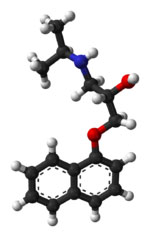Propanolol Is…
a beta blocker. Most commonly used to treat hypertension Propanolol is also used in angina, tremor, migraine, anxiety, tachycardia,, post traumatic stress syndrome and, interestingly enough, post-exertional headache.
Fibromyalgia, POTS and Chronic Fatigue Syndrome (ME/CFS)
Light et. al. found low-dose propanolol reduced overall pain, helped with standing and moderately increased cortisol in FM patients. Increased pain in response to an ischemic challenge suggested that the increased vasoconstriction caused by propanolol induced hypoxia. Light believes propanolol is able to act on the local sensory receptors in the muscle to reduce pain in ME/CFS/FM but cautioned that higher doses could have the opposite effect by ramping up sympathetic nervous system activity.
Raj et. al found that low doses of propanolol (20 mg) significantly reduced tachycardia (rapid heart beat) and symptoms in postural tachycardia (POTS) when standing while higher doses, in some cases, made symptoms worse. Raj reported that 10-20 mgs. was the most effective dose for his patients. At the 2018 Dysautonomia International Conference Dr Biaggioni of Vanderbilt reported that propanolol can effectively block the sympathetic nervous system overdrive in hyperadrenergic POTS.
Reporting on one case study, Wyller proposed propanolol could blunt the sympathetic nervous system activation in chronic fatigue syndrome.

At low doses propanolol may be able to reduce pain and improve symptoms in ME/CFS/FM without increasing sympathetic nervous system activity
Light talked about the paradoxical use of beta and alpha blockers in a disorder largely believed to be characterized by SNS activation (which they accentuate). He believes low dose (1/5-1/10th normal) propanolol blocks sensory receptor activity without activating the adrenergic receptors that constrict the blood vessels. By blocking sensory receptor activity – which itself activates the SNS – propanolol, an SNS activator, may actually serves to reduce SNS activity.
“Theoretically, beta and alpha blockers should actually make CFS patients worse, because the prevailing theory (with some pretty good evidence) is that vascular smooth muscle alpha and beta receptors are DOWN regulated (are effectively non-functional) due to an “overdrive” of the sympathetic nervous system.
Activation of these receptors is essential for proper control of blood flow in skeletal muscles and perhaps also the brain. Without proper control, the amount of metabolites signaling fatigue and muscle pain could swing wildly, leading to the sensation of fatigue with even modest movement, and even at rest. Worse, it could lead to orthostatic hypotension (a very common symptom in CFS patients) that could cause the patient to faint when standing, or even sitting upright.
What we found is that there are also alpha and beta receptors on both the muscle sensory neurons that signal fatigue and also those that signal muscle pain, as well as on circulating immune cells. We further found that the receptors on the sensory neurons and immune cells were blocked at lower doses (1 tenth the dose) than is necessary to block alpha and beta receptors on vascular smooth muscle.
This means that low doses of propranolol (again 1/5 to 1/10 the dose that is prescribed for blood pressure control) can block the sensory receptors, reducing the total signal to the sympathetic nervous system, allowing the normal sympathetic reflexes to be re-established, leading to much more normal control of metabolite levels in muscle and brain.
(Much of this last section is still speculation-only inferred from the data we have on blood pressure and vascular control in FM patients, published in Adrenergic dysregulation and pain with and without acute beta-blockade in women with fibromyalgia and temporomandibular disorder. Light KC, Bragdon EE, Grewen KM, Brownley KA, Girdler SS, Maixner W.J Pain. 2009 May;10(5):542-52.).”
Dose
Light and Raj suggest doses low doses at 1/5th to 1/10 the size (10-20 mgs/day) of those normally used to affect blood pressure are most effective in POTS and ME/CFS. See above for the explanation why.






